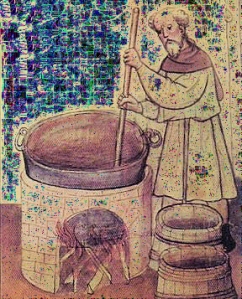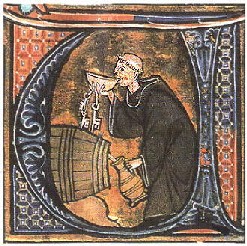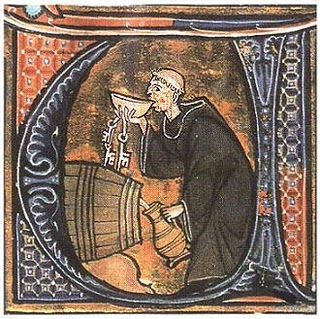
Monk brewing beer.
Anyone that knows me should have seen this one coming; my tribute to those fine monks who for centuries have preserved the art of beer making. Didn’t know that monks made beer? Well neither did I until about eight years ago when I stumbled into a local brewery called St. Sabastiaans and ordered their private reserve. The waiter brought out a goblet, which was strange to have a beer come in. The goblet was filled a bright golden ale which had an amazing fruity aroma; unlike any beer I was familiar with. I lifted the ale to my lips and suddenly flavor, unlike anything I had ever experienced in a beer, filled my mouth… I placed the goblet back onto the table to ponder what had just happened and slowly my cheeks started to warm up and then a grin formed which I was unable to “un-grin” for about an hour.
St. Sabastiaans is an Abbey style ale, which means it’s not really made by monks or a monastery but draws from that tradition of beer-making, and they are not alone. Abbey style ales are growing more popular yearly and most micro or craft breweries are offering up their take on Belgian ales for the world to enjoy. For example, Ommegang brewery in Cooperstown, NY, is an american brewery devoted to making Belgian style ales.

The seven Trappist Ales
Probably the most noteworthy Belgian ales come from the Trappists. There are many Trappist monasteries today, but only 7 are beer makers, six of which are in Belgium. The Trappist Logo can only be found on these beers. One of the more popular Trappist ales that I’ve seen is Chimay, who also make cheese, another of the great monastic traditions. Chimay makes three beers, a trippel (gold), a grande reserve (blue) and a premier (red)
Other monasteries also produce Belgian ales but are not under the control of the Trappists. These are called Abbey ales, but because there is no monitoring organization behind this name, the term can apply to an actual monastery beer or to any beer made in the style of an Abbey ale.
Most of the breweries around today are a few hundred years old, but there are some that do date back further. The oldest brewery is Weihenstephan brewery. Founded in 740 the Benedictine abbey didn’t begin to produce beer until 1040 and thought the Abbey wsa dissolved in 1803 it is still in operation as a brewery today. Weihenstephan produces German style beers which differ from the Belgian but are also wonderful on the palate.

Illuminated letter with monk sipping beer.
Monks have been brewing beer since…. well that’s a good question. It could be guessed that they may have been doing so every since monasteries were first formed. Beer as well as wine were basically water substitutes because water was not the the best thing to drink back then. The process in brewing offered a drink that was not only free from pollutants found in water, but also provided sustenance. Beer was good at breakfast, lunch or dinner, and was drunk by men, women and children. The fact that monasteries were often self supporting and provided hospitality to the traveller, it seems likely that beer was there early on.
What we do know is that in the 9th century there is evidence of beer being made better. It appears that under the control of monastic communities, the process was refined, recipes, methods of cooking and preserving developed and so the tradition of beer making begins. This could very well be where the scientific method began to develop as methods of brewing and ingredients were constantly being tested and developed to bring about a better product. One noteworthy ingredient is the use of Hops as a preservative, which are first mentioned in 822 by a Carolingian Abbot and later in the 12th century by Hildegard von Bingen, a Benedictine Abbess. Hildegard states: “(Hops), when put in beer, stops putrification and lends longer durability.”
I’ve been a homebrewer for 3 years now and have personally made several of the Belgian style beers as well as those from the German and Brittain traditions. It’s a little more effort, which goes without saying, but well worth it when all is done. That and you can cut down the cost by about half which can really save some money if your into good beer. Belgian ales, especially Trappist can go for over ten bucks for a 4-pack. Still it’s always a treat to get the real deal and enjoy a delicious beer that has centuries of tradition behind it.
Posted in
Book of Hours,
History,
Iconography and Art,
Illuminated Manuscripts,
Middle Ages,
Tradition,
Uncategorized and tagged
abbey ale,
ale,
beer,
craft beer,
hildegard von bingen,
hops,
monasteries,
religion,
tradition,
trappist ale,
trippel |
 Last week I bottled my first batch of beer since our move to North Carolina. It’s been nine months since my last brewing and while I was a little nervous about forgetting something important; the whole process went very smooth. It was a little awkward working in a new kitchen but apart from that it was certainly good to be back at it.
Last week I bottled my first batch of beer since our move to North Carolina. It’s been nine months since my last brewing and while I was a little nervous about forgetting something important; the whole process went very smooth. It was a little awkward working in a new kitchen but apart from that it was certainly good to be back at it.


